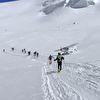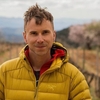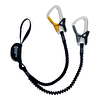Amiata trad climbing in Tuscany
Trad climbing around Monte Amiata in Tuscany, Italy, introduced by Federico Schlatter.
The name Amiata probably derives from the Latin "Ad meata" i.e. "at the source" or, according to others, from Mons Tuniatus (subsequently Montuniata) i.e. Monte di Tunia, the most important Etruscan deity. This detail aside, the 1738 metre high dormant volcano is surrounded by lush chestnut and beech forests, is rich in wildlife, natural springs and great people and is most certainly an area which, if not sacred, is magical and highly fragile.
Climbers have long-known about the quantity and quality of the trachyte boulders, hidden from view and dotted almost everywhere across the slopes of this volcano, and currently there are circa 200 boulder problems. Less is known about the higher outcrops and although there are approximately 150 sport climbs developed above all by Bengio Chiesi, in reality Pandora's box was only recently opened by two of Amiata's most psychotic climbers (namely myself and Michele Caminati) who have discovered a great playground for trad climbing or, if you prefer, clean climbing. Truly unique, especially in Central Italy ...
Due to its morphology the volcanic rock with its cracks and pockets is wonderfully suited to trad climbing with Friends and, in particular, tricams. Watch out though as some flakes and tafoni are fairly fragile... The slopes are littered with these outcrops and the surrounding chestnut groves, although on private land, can be accessed freely (except for the harvest time when they are strictly off-limits) if treated with the utmost respect, leaving them in better condition then as you find them. Only a minor portion of the area's trad potential has have been cleaned and repeated. Furthermore, it is also possible to repeat almost all existing sport climbs (from 4a to 7c/8a) as trad climbs. Given the uniqueness of this area, the local climbers have responded very positively to this new approach.
TOPO: trad climbing at Amiata
Federico Schlatter - short CV
Born in Florence on 12/05/1962
I started climbing in 1976 with the Prato branch of the Italian Alpine Club. In the years that followed I made the first ascent of several routes in the Apuan Alps, some of which were extremely difficulty (at least for the time) including "Il muro delle ombre" on the North Face of Pizzo d'Uccello. This has only seen two documented repeats in almost thirty years. In 1981 I took part in an expedition to the Kashmir Himalayas, while in 1985 I took part in the very first climbing competition in Bardonecchia "Sports Roccia" and placed in the top 20. The birth of sports climbing and its progressive standardisation led me to explore other sports: from paragliding - of which I was a pioneer - to surfing as a pro. In 1999 I became the first Italian to qualify for the ASP World Championship in Australia.
At the same time I began my professional career as a photographer and as director of photography for films. I recently started climbing again after a "mere" 18-year pause: I've rediscovered a world which has undergone a radical renewal where the approach to the form of climbing I loved so much has even been categorised and is distinct from the rest... trad climbing or, if you want, by fair means.
In Italy, especially in the areas where I climb around Rome, sport climbing undoubtedly predominates and my arrival with a haulbag and trad gear certainly raised a few eyebrows. I was intent of "anarchically" climbing lines, even sports routes, and didn't give a damn about previously defined routes... but so be it, the game and exploration continues!
Climbers have long-known about the quantity and quality of the trachyte boulders, hidden from view and dotted almost everywhere across the slopes of this volcano, and currently there are circa 200 boulder problems. Less is known about the higher outcrops and although there are approximately 150 sport climbs developed above all by Bengio Chiesi, in reality Pandora's box was only recently opened by two of Amiata's most psychotic climbers (namely myself and Michele Caminati) who have discovered a great playground for trad climbing or, if you prefer, clean climbing. Truly unique, especially in Central Italy ...
Due to its morphology the volcanic rock with its cracks and pockets is wonderfully suited to trad climbing with Friends and, in particular, tricams. Watch out though as some flakes and tafoni are fairly fragile... The slopes are littered with these outcrops and the surrounding chestnut groves, although on private land, can be accessed freely (except for the harvest time when they are strictly off-limits) if treated with the utmost respect, leaving them in better condition then as you find them. Only a minor portion of the area's trad potential has have been cleaned and repeated. Furthermore, it is also possible to repeat almost all existing sport climbs (from 4a to 7c/8a) as trad climbs. Given the uniqueness of this area, the local climbers have responded very positively to this new approach.
TOPO: trad climbing at Amiata
Federico Schlatter - short CV
Born in Florence on 12/05/1962
I started climbing in 1976 with the Prato branch of the Italian Alpine Club. In the years that followed I made the first ascent of several routes in the Apuan Alps, some of which were extremely difficulty (at least for the time) including "Il muro delle ombre" on the North Face of Pizzo d'Uccello. This has only seen two documented repeats in almost thirty years. In 1981 I took part in an expedition to the Kashmir Himalayas, while in 1985 I took part in the very first climbing competition in Bardonecchia "Sports Roccia" and placed in the top 20. The birth of sports climbing and its progressive standardisation led me to explore other sports: from paragliding - of which I was a pioneer - to surfing as a pro. In 1999 I became the first Italian to qualify for the ASP World Championship in Australia.
At the same time I began my professional career as a photographer and as director of photography for films. I recently started climbing again after a "mere" 18-year pause: I've rediscovered a world which has undergone a radical renewal where the approach to the form of climbing I loved so much has even been categorised and is distinct from the rest... trad climbing or, if you want, by fair means.
In Italy, especially in the areas where I climb around Rome, sport climbing undoubtedly predominates and my arrival with a haulbag and trad gear certainly raised a few eyebrows. I was intent of "anarchically" climbing lines, even sports routes, and didn't give a damn about previously defined routes... but so be it, the game and exploration continues!
Latest news
Expo / News
Expo / Products
A lightweight and essential mountaineering backpack
Compact lightweight shock absorber with elastic arms for via ferrata.
A lightweight, stretchy, and comfortable T-shirt.
Fully adjustable harness with four buckles, ideal for mountaineering, winter climbing and via ferrata.
Ever since its market launch, the Barryvox avalanche transceiver has been among the most reliable transceivers in the world.
Merino Wool Mountaineering Sock.



 1 / 4
1 / 4
 Copia link
Copia link

 archivio Federico Schlatter
archivio Federico Schlatter






















